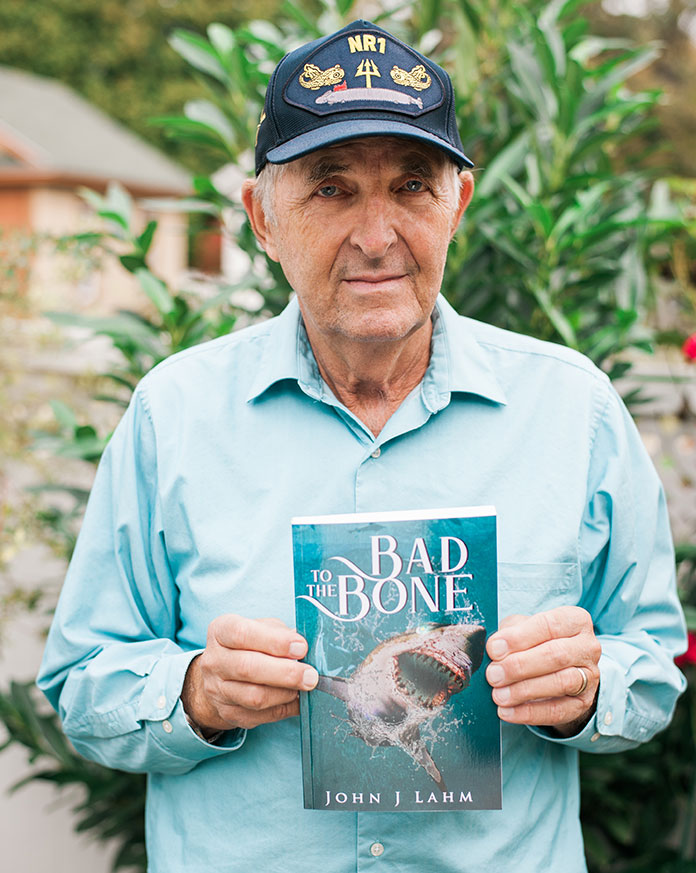
LONG BEACH ISLAND – John J. Lahm has a passion for fishing, writing and undersea history and he’s put each of those interests into the creation of his book, “Bad to the Bone.”
Lahm, a retired crane operator from the U.S. Navy, is a member of the Long Beach Island Fishing Club in Harvey Cedars. The Philadelphia resident released his book this past summer. It begins with the unexpected arrival of a new species of shark that mutated due to medical waste seeping down through a Florida aquifer.
His book provides a horrific tale of shark attacks reminiscent of books like “Jaws” but there is a twist as these sharks are a new breed that crave not only human flesh but human blood and bone marrow due to their ingesting medical byproducts for decades.
The story reveals that when the shark becomes full-grown, they are the largest predator on the planet. It takes place around the Kings Bay Nuclear Submarine Base in St. Mary’s, Georgia which was built in the late 1970s.
“I contacted a publisher down in Florida (Seaworthy Publications) and he didn’t know I was the same guy submitting work to him over the last five years but he took me on. It is very hard to get a publisher.”
Lahm said it was some shark teeth that inspired him to write his tale of mystery and horror. He noted that someone had discovered them during a dredging operation and they obviously came from a very large shark.
“They were black as night, shiny as a boot and as big as your hand. I had the impression they were some kind of shark tooth but I wasn’t sure,” Lahm told The Southern Ocean Times. In his book, after the Navy removes a limestone mound during their dredging operation, the sharks begin their feeding frenzy. A school of hungry sharks emerges from the submarine springs which is their birthplace in Kings Bay.

The writer said that while his book is fiction, he took a lot of ideas from real life experiences he has had over the course of his long career. “I have a tendency to collect things in my head. I said to myself, this is where this story should take place inside the center core of one third of our nuclear weaponry so the reader can only get in there with his mind. I do my research.”
He recalled while working in Delaware County, Pennsylvania years ago “we had 2,000 people on the job and an odd-looking ship came up river and we all stopped working and the guy next to me said, ‘that’s a Howard Hughes boat.’”
It was the Glomar Explorer formerly the USNS Hughes Glomar Explorer which was a deep-sea drillship platform built for Project Azorian which was the secret 1974 U.S. Central Intelligence Agency’s special activities division effort to recover Soviet submarine K-129.
“Later on, a guy who worked as rigger told me that (Glomar) was the only ship he ever worked on that they put the keel, the first piece of iron on the dry dock and they had men with shotguns walking around.”
After the Philadelphia shipyard was shut down, Lahm transferred to Kings Bay Nuclear Submarine Base “and that is where the story in the book originates,” he said. He noted that the black shark teeth that would wash up during certain periods of the dredging operations could be sold in town “for $5 a piece.”
The plot includes the building of a Navy base along with a four-lane highway connecting to I-95 and also includes the environmental concerns of the Timucua people who inhabited land first in southeast Georgia and northern Florida who fear the dredging work by the Navy will destroy the plant life and burial sites there.
As in “Jaws” tourism is threatened after the attacks begins and the danger extends to New England. The Glomer Explorer also makes a cameo in the story.
Lahm was successful in petitioning the Pennsylvania Historical and Museum Commission to approve a historical marker nomination for the Glomar Explorer. The spy ship was built using funds donated by Howard Hughes. The marker remains outside the Independence Seaport Museum.
The writer contacted the United States Board on Geographic Names’ Advisory Committee on Undersea Features after it was discovered that the research vessel NR-1 located a submarine spring. Lahm asked that the spring be named the NR-1 Hole. That request was granted and the National Oceanic and Atmospheric Administration include that name on all their charts.
Lahm also submitted documents to Geo-Marine Letters, (an international peer-reviewed journal which offers rapid publication of concise original studies) of the sinkholes surveyed in the Florida Straits four years ago. He believes “the collapse of the Champlain High Rise in Miami Beach (on June 24) was caused by the Miami submarine spring, nine miles east of Miami Beach.”
“Bad to the Bone” is available in paperback and Kindle through barnesandnoble.com.
"fisherman" - Google News
December 17, 2021 at 08:45PM
https://ift.tt/3mdemOD
LBI Fisherman's Book Is “Bad To The Bone” - Jersey Shore Online
"fisherman" - Google News
https://ift.tt/35ujXVg
Shoes Man Tutorial
Pos News Update
Meme Update
Korean Entertainment News
Japan News Update
Bagikan Berita Ini














0 Response to "LBI Fisherman's Book Is “Bad To The Bone” - Jersey Shore Online"
Post a Comment